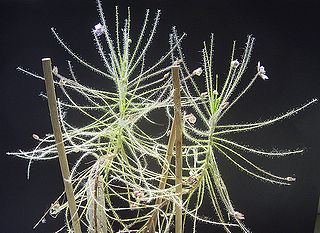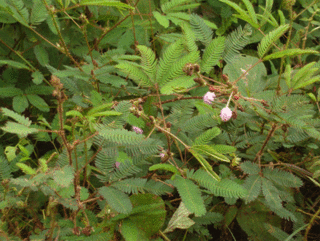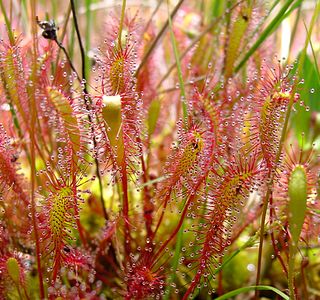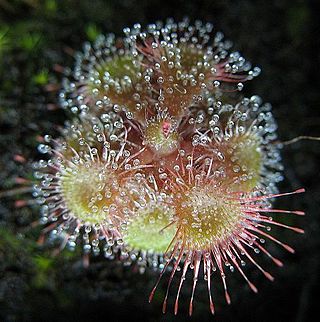
Drosera, which is commonly known as the sundews, is one of the largest genera of carnivorous plants, with at least 194 species. These members of the family Droseraceae lure, capture, and digest insects using stalked mucilaginous glands covering their leaf surfaces. The insects are used to supplement the poor mineral nutrition of the soil in which the plants grow. Various species, which vary greatly in size and form, are native to every continent except Antarctica.

Droseraceae is a family of carnivorous flowering plants, also known as the sundew family. It consists of approximately 180 species in three extant genera. Representatives of the Droseraceae are found on all continents except Antarctica.

Byblis is a small genus of carnivorous plants, sometimes termed the rainbow plants for the attractive appearance of their mucilage-covered leaves in bright sunshine. Native to Australia and New Guinea, it is the only genus in the family Byblidaceae. The first species in the genus was described by the English botanist Richard Anthony Salisbury in 1808. Eight species are now recognized.

Roridula is a genus of evergreen, insect-trapping shrubs, with two species, of about 1⅓–2 m. It is the only genus in the family Roridulaceae. It has thin, woody, shyly branching, upright, initially brown, later grey stems, with lance- to awl-shaped leaves crowded at their tips. The star-symmetrical flowers consist from the outside in of five, green or reddish, free sepals, alternating with five white, pink or purple, free petals. Further to the middle and opposite the sepals are five stamens with the anthers initially kinked down. These suddenly flip up if the nectar-containing swelling at its base is being touched. The center of the flower is occupied by a superior ovary. The leaves and sepals carry many sticky tentacles of different sizes, that trap insects. Roridula does not break down the insect proteins, but bugs of the genus Pameridea prey on the trapped insects. These later deposit their feces on the leaves, which take up nutrients from the droppings. The species can be found in the Western Cape province of South Africa. They are commonly known as dewstick or fly bush in English and vlieëbos or vlieëbossie in Afrikaans.

Drosera capensis, commonly known as the Cape sundew, is a small rosette-forming carnivorous species of perennial sundew native to the Cape in South Africa. Because of its size, easy to grow nature, and the copious amounts of seed it produces, it has become one of the most common sundews in cultivation, and thus, one of the most frequently introduced and naturalised invasive Drosera species.

Drosera rotundifolia, the round-leaved sundew, roundleaf sundew, or common sundew, is a carnivorous species of flowering plant that grows in bogs, marshes and fens. One of the most widespread sundew species, it has a circumboreal distribution, being found in all of northern Europe, much of Siberia, large parts of northern North America, Korea and Japan but is also found as far south as California, Mississippi and Alabama in the United States of America and in New Guinea.

Drosera regia, commonly known as the king sundew, is a carnivorous plant in the sundew genus Drosera that is endemic to a single valley in South Africa. The genus name Drosera comes from the Greek word droseros, meaning "dew-covered". The specific epithet regia is derived from the Latin for "royal", a reference to the "striking appearance" of the species. Individual leaves can reach 70 cm (28 in) in length. It has many unusual relict characteristics not found in most other Drosera species, including woody rhizomes, operculate pollen, and the lack of circinate vernation in scape growth. All of these factors, combined with molecular data from phylogenetic analysis, contribute to the evidence that D. regia possesses some of the most ancient characteristics within the genus. Some of these are shared with the related Venus flytrap (Dionaea muscipula), which suggests a close evolutionary relationship.

Aldrovanda is a genus of carnivorous plants encompassing one extant species and numerous extinct taxa. The genus is named in honor of the Italian naturalist Ulisse Aldrovandi, the founder of the Botanical Garden of Bologna, Orto Botanico dell'Università di Bologna. Aldrovanda vesiculosa has been reported from scattered locations in Europe, Asia, Africa, and Australia.

In biology, thigmonasty or seismonasty is the nastic (non-directional) response of a plant or fungus to touch or vibration. Conspicuous examples of thigmonasty include many species in the leguminous subfamily Mimosoideae, active carnivorous plants such as Dionaea and a wide range of pollination mechanisms.

Drosera anglica, commonly known as the English sundew or great sundew, is a carnivorous flowering plant species belonging to the sundew family Droseraceae. It is a temperate species with a circumboreal range, although it does occur as far south as Japan, southern Europe, and the island of Kauai in Hawaii, where it grows as a tropical sundew. It is thought to originate from an amphidiploid hybrid of D. rotundifolia and D. linearis, meaning that a sterile hybrid between these two species doubled its chromosomes to produce fertile progeny which stabilized into the current D. anglica.

Drosera hartmeyerorum is a summer-growing annual sundew that is native to the north of Western Australia. It was discovered in 1995 by Siegfried and Irmgard Hartmeyer. Drosera hartmeyerorum has long scrambling leaves which readily curl around any unfortunate insect that lands on the leaves. One major thing that separates this sundew from others are the round yellow trichomes at the base of the leaves. The function of the yellow trichomes is uncertain. Like most sundews, it grows in warm wet, sandy, peaty areas with high humidity and low nutrient levels in the soil.

Drosera burmanni, the tropical sundew, is a small, compact species in the carnivorous plant genus Drosera. Its natural geographical range includes the tropical and subtropical regions of Asia, Australia, India, Japan, southeast Asia, Oceania, Africa and China's Guangxi, Guangdong, Yunnan, Fujian, Taiwan. It normally spans only 2 cm (0.8 in) in diameter. It is one of the fastest trapping sundews as well, and its leaves can curl around an insect in only a few seconds, compared to the minutes or hours it takes other sundews to surround their prey. In nature, D. burmanni is an annual, but in cultivation, when grown indoors during the cold months, it can live for many years. Since D. burmanni is an annual, it produces large amounts of seed. Drosera burmanni has been considered a powerful rubefacient in Ayurveda.

Carnivorous plants are plants that derive some or most of their nutrients from trapping and consuming animals or protozoans, typically insects and other arthropods, and occasionally small mammals and birds. They still generate all of their energy from photosynthesis. They have adapted to grow in places where the soil is thin or poor in nutrients, especially nitrogen, such as acidic bogs. They can be found on all continents except Antarctica, as well as many Pacific islands. In 1875, Charles Darwin published Insectivorous Plants, the first treatise to recognize the significance of carnivory in plants, describing years of painstaking research.

Drosera subg. Thelocalyx is a subgenus of two species in the genus Drosera.

Drosera hamiltonii, the rosy sundew, is a small, compact species in the carnivorous plant genus Drosera and is the only species in the monotypic subgenus Stelogyne. The glandular leaves are about 2 cm (0.8 in) long and arranged in a rosette. In November and December, pink flowers on 30 cm (12 in) tall scapes bloom. It is endemic to coastal swamps in south-west Western Australia. It was first described by Cecil Rollo Payton Andrews in 1903 and placed in section Stelogyne as the only species by Ludwig Diels in 1906. In 1994, Rüdiger Seine and Wilhelm Barthlott suggested D. hamiltonii belonged in their section Drosera, reducing section Stelogyne to synonymy with section Drosera. In 1996, Jan Schlauer revised the genus classification and elevated section Stelogyne to a subgenus, arguing that the unique fused styles requires segregation at more than a sectional rank.

Drosera uniflora is a species in the carnivorous plant genus Drosera that is native to southern Chile, Argentina, and the Falkland Islands. It is a tiny sundew with a solitary white flower as its name would suggest. Stalked glands on its leaves, which secrete sticky mucilage at the tips, are used to capture and hold insect prey, from which the plant derives the nutrients it cannot obtain in sufficient quantity from the soil. It was formally described in 1809 by botanist Carl Ludwig Willdenow.
Drosera peruensis is a carnivorous plant of the genus Drosera, commonly known as the Peruvian sundew. This Drosera species was first identified in Peru in 2002 by Tânia Regina dos Santos Silva and Mireya D. Correa following work to update the genus Drosera for the reference text, Flora Neotropica..

In botany, tentacles are glandular hairs on the leaves of some species of insectivorous plants such as Drosera (sundews). Tentacles are different from organs such as the tendrils of climbing plants.

Steel trap is an informal term in the study of comparative plant physiology of the carnivorous plants. "Steel trap", more particularly "active steel trap", refers to prey capture devices such as occur in some members of the family Droseraceae, and in particular in the genera Dionaea and Aldrovanda ("waterwheel"). The term apparently originated with the author Francis Ernest Lloyd in 1942, in which he adopted the overly general term "steel trap" rather than say, "gin trap" or a more adjectival form, for devices such as the lobed trap leaves of Dionaea.

Drosera admirabilis, commonly referred to as the "floating sundew", is in the carnivorous us plant family Droseraceae. The nickname "admirabilis" was first used in literature by Paul Debbert in 1987 and was derived from how "admirable" the plant appears when it reaches a fully matured specimen. Structurally similar to Drosera aliciae, and Drosera cuneifolia, the D. admirabilis grows in a single tight rosette-shaped leaf bundle. The leaves widen towards the end and have rounded tips. Leaves lay horizontally under proper lighting conditions. Like many other African sundews, D. admirabilis is a perennial. D. admirabilis has outer tentacles like those of Drosera glanduligera, Drosera sessilifolia and Drosera burmannii which briefly after stimulation bend towards the prey.



















